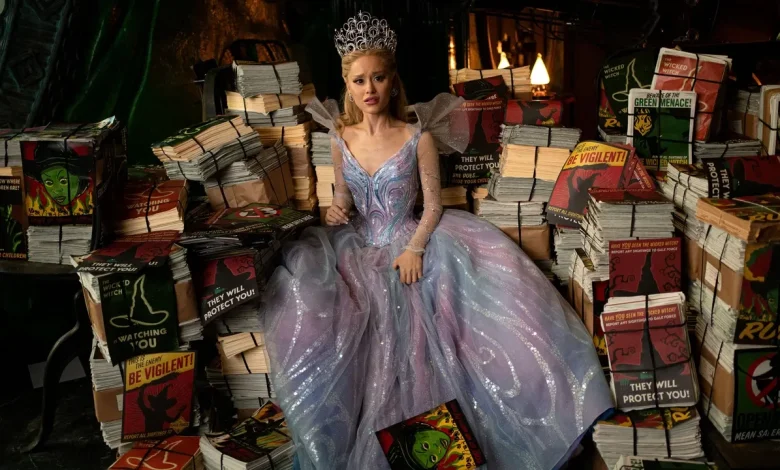“Wicked: For Good” Is Very, Very Bad

As part of an anti-Wicked Witch of the West smear campaign, Morrible tries to ensnare the loyalties of Elphaba’s closest ex-classmates: Glinda, a smiling yet conflicted mascot for the Oztocracy, and the dashing Prince Fiyero (Jonathan Bailey), now captain of the Wizard’s guard. But Fiyero’s heart belongs to Elphaba, and, even as he and Glinda are pressured into a very public engagement, the air is thick with political and emotional subterfuge. Theirs is not the only romantic complication afoot. For my taste, too much of “Wicked: For Good” plays like “Oz the World Turns,” though I’d credit most daytime soap operas with superior production values. Why is everything in this movie, for all its lavishly gilded, emerald-studded set design, either too dim or too bright—so blindingly backlit that Oz seems to be under perpetual thermonuclear attack, or so murky that you could scarcely tell a monkey from a Munchkin?
Munchkinland, as it happens, is now governed by Elphaba’s younger sister, Nessarose (Marissa Bode), who does not share her sibling’s ironclad integrity. Nessarose uses a wheelchair, and one of the most wretched aspects of “Wicked: For Good” is its conflation of physical disability and soul-crushing bitterness. Nessarose has been given nothing else to express; she’s clingy, thwarted jealousy personified. She resents Elphaba for her rebellion, just as she resents Boq (Ethan Slater), a Munchkin she loves, for abandoning her to pursue Glinda. Boq’s surname, by the way, is Woodsman, and you needn’t be an Ozphile to sense the grim direction in which all this is headed. Just follow the yellow brick road.
This, as far as I can tell, is why “Wicked: For Good” exists: so that the events of Baum’s novel and the 1939 film, forever conjoined in the public imagination, can be maneuvered into position. But must they be maneuvered so clumsily, and with such a glaring absence of brains or heart? In time, we will be introduced to Dorothy Gale—cue a few flashes of gingham—and force-fed origin stories for her travelling companions, which range from the nonsensically contrived to the gratuitously traumatizing. (Even if your children can stomach the Tin Man’s arrival, the Scarecrow’s cornfield crucifixion might be the last straw.) Onstage, all this narrative retconning has a breezy behind-the-scenes cleverness, as if the story were being slyly fleshed out in the margins. Onscreen, and on full display, it’s close to an abomination—a travesty of fairy-tale logic and pop-cultural memory. By the time Dorothy and her friends march on Elphaba’s lair, there seems to be something more pernicious than mere mediocrity at work. It’s as if the picture were so cowed by its iconic predecessor that it could only respond with a petulant urge to destroy the classic it could never be.
Maguire’s novel was itself written in the spirit of a corrective; it aimed to bring a morally ambiguous modernism and a grownup, forthright sexuality to bear on Baum’s squeaky-clean demarcations of good and evil. But on the carnal front, at least, the musical is made of softer stuff. The less said the better about Elphaba and Fiyero’s drippy seduction number (“Somehow I’ve fallen / under your spell / And somehow I’m feeling / it’s up that I fell”), or about what passes, miserably, for pillow talk: “You’re beautiful,” Fiyero coos, and, when Elphaba accuses him of lying, he replies, “It’s not lying. It’s looking at things in another way.” How’s that for flattery?
Some legitimate passion does erupt when Elphaba and Glinda, reunited by tragedy, let their long-simmering rivalry bubble over in a wand-versus-broomstick smackdown. Which witch emerges victorious—not just from that catfight but from the whole of this busy, confused, hopelessly mangled movie? I’d say the film is fortunate to have them both. In the first installment, Erivo made common decency feel dramatic; here, it’s satisfying to see Elphaba in aggressive defiance of the Wizard’s regime. Grande, too, has come into her own. After her delicate comic high jinks in “Part I,” she has the trickier task of expressing Glinda’s first real experience of rejection and disillusionment. “It’s time for her bubble to pop,” she sings of herself, in a quavering ballad—one of two new songs, neither memorable, that Schwartz wrote for the film. This rare moment of self-awareness arrives at perhaps the least opportune time: Glinda is in her luxurious tower room, watching from on high as the Emerald City descends into chaos.
It’s tone-deaf but honest. “Wicked: For Good” is littered with references to the idiot masses of Oz—their gullibility, their venality, their stupidity. Elphaba uses this as justification for why she must ultimately sacrifice herself and become a public symbol of evil incarnate: as she tells Glinda, “They need someone to be wicked, so that you can be good.” The Wizard espouses his own version of this idea, confident that the public can be appeased by the illusion of a common enemy. The cynicism, although hardly misplaced, feels thoroughly unearned. The “Wicked” movies never convince us—in the way that “The Wizard of Oz” or Walter Murch’s darkly thrilling “Return to Oz” (1985) convinced us—of the fantastical reality of Oz as an actual place. Chu and his screenwriters evince no curiosity about the history, culture, and politics of the realm, or even about the potential stakes of the people’s capitulation to the Wizard’s fascism. The citizens of Oz are treated as no more than an undifferentiated crowd of extras, an ignorant and finally disposable monolith. The movie’s flattery of the audience, and of our supposedly superior conscience, is an expression of the same contempt. ♦




